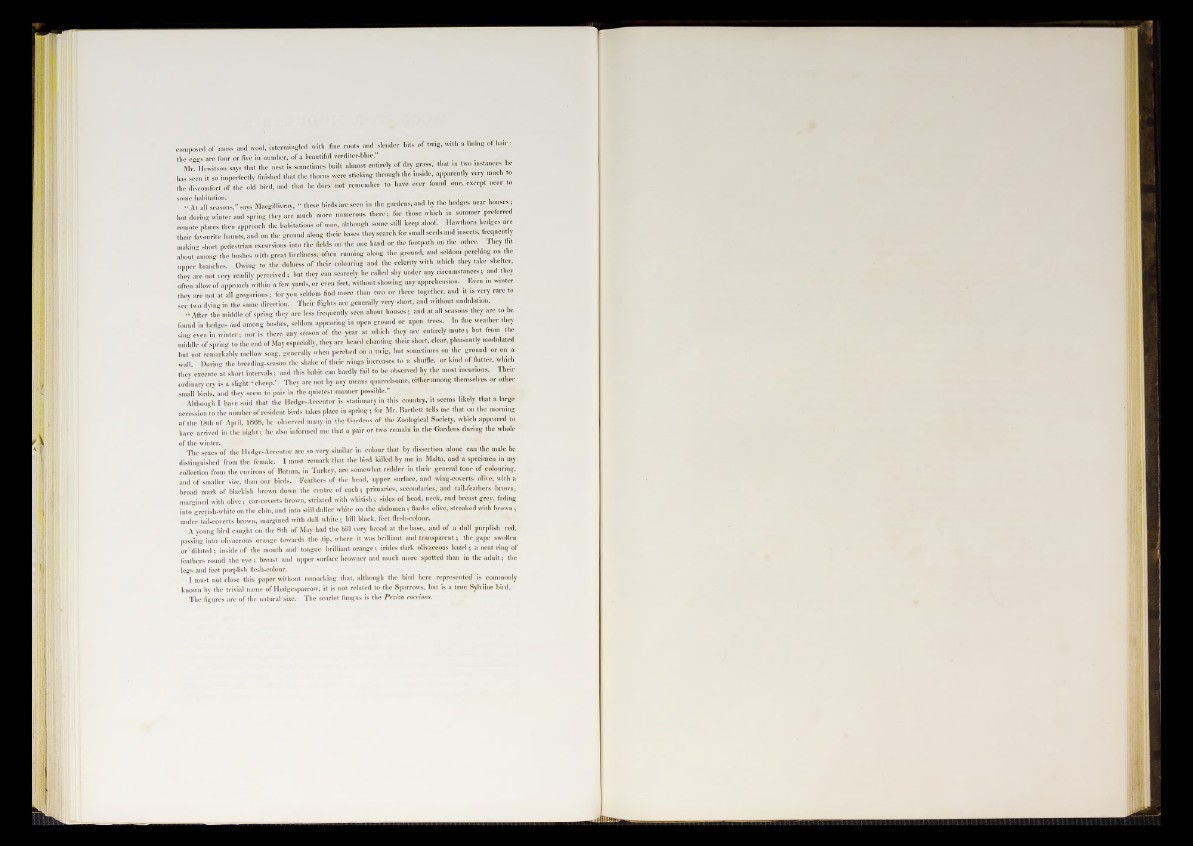
composed of moss and wool, intermingled with line roots and R ender hits of twig, with a lining of hair :
the ec"S are four or five in number, of a beautiful verditer-blue. I
Mr Hewitson says that the nest is sometimes built almost entirely of dry grass, that | two .„stances he
has seen it so imperfectly finished that the thorns were sticking through the ms.de, apparently very much to
the discomfort of the old bird, and that he does not remember to have ever found one, except near to
some habitation. .
“ At all seasons,” says Macgillivray, | these birds are seen in the gardens, and by the hedges near houses;
but during winter and spring they are much more numerous there; for those which in summer preferred
remote places then approach the habitations of man, although some still keep aloof. Hawthorn hedges are
their favourite haunts, and on the ground along their bases they search for small seeds and ...sects, frequend;
making short pedestrian excursions into the fields on the one hand or the footpath on the other. They flit
about among the bushes with great liveliness, often running along the ground, and seldom perching on the
upper branches. Owing to the dulness of their colouring and the celerity with which they take shelter,
they are not very readily perceived; but they can scarcely be called shy under any c.rcumstances; and they
often allow of approach within a few yards, or even feet, without showing any apprehension. Even ... w.nter
they are not at all gregarious; for yon seldom find more than two or three together, and it is very rare to
see two flying in the same direction. Their flights are generally very short, and without undulation.
'• After the middle of spring they are less frequently seen about houses; and a t all seasons they are to he
found in hedges and among bushes, seldom appearing in open ground or upou trees. In fine weather they
sing even in winter; nor is there any season of the year at which they are entirely mute; but from the
middle of spring to the end o f May especially, they are heard chanting their short, clear, pleasantly modulated
but not remarkably mellow song, generally when perched on a twig, hut sometimes on the ground or on a
wall During the breeding-season the shake of their wings increases to a shuffle, or kind of flutter, which
they execute at short intervals; and this habit can hardly fail to be observed by the most incurious. Their
ordinary cry is a slight ■ cheep.’ They are not by any means quarrelsome, either among themselves or other
small birds, and they seem to pair in the quietest manner possible.”
Although I have said that the Hedge-Accentor is stationary in this country, it seems likely that a large
accession to the number of resident birds takes place in spring; for Mr. Bartlett tells me that on the morning
of the 18th of April, 1868, he observed many in the Gardens of the Zoological Society, which appeared to
have arrived in the nig h t; he also informed me that a pair or two remain in the Gardens during the whole
of the winter.
The sexes of the Hedge-Accentor are so very similar in colour that by dissection alone can the male be
distinguished from the female. I must remark that the bird killed by me in Malta, and a specimen in my
collection from the environs of Batum, in Turkey, are somewhat redder in their general tone of colouring,
and of smaller size, than onr birds. Feathers of the head, upper surface, and wing-coverts olive, with a
broad mark of blackish brown down the centre of each; primaries, secondaries, and tail-feathers brown,
margined with olive; ear-coverts brown, striated with whitish ; sides of head, neck, and breast grey, fading
into greyish-white on the chin, and into still duller white on the abdomen; flanks olive, streaked with brown;
under tail-coverts brown, margined with dull white; hill black, feet flesh-colour.
A young bird caught on the 8th of May had the bill very broad at the base, and of a doll purplish red,
passing into olivaceous orange towards the tip, where it was brilliant and transparent; the gape swollen
or dilated; inside of the month and tongue brilliant orange; ¡rides dark olivaceous hazel; a neat ring of
feathers round the ey e ; breast and upper surface browner and much more spotted than in the ad u lt; the
legs and feet purplish flesh-colour.
I must not close this paper without remarking that, although the bird here represented is commonly
known by the trivial name of Hedgesparrow, it is not related to the Sparrows, but is a true Sylviine bird.
The figures are of the uatural size. The scarlet fungus is the Peniza coccinea. '